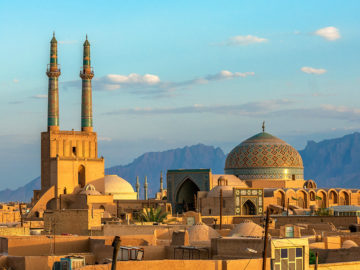
The magnificent Jameh Mosque of Yazd City that took over 100 years to be built encompasses three historical architectural periods. First, a Sassanid (224-651 CE) fire temple was built with a structure known as ChaharTaghi; a common style for fire temples that is consisted of four pillars connected to four arches and a dome ceiling.
Second, following the advent of Islam and the beginning of Islamic-Persian art, the Sassanid ChaharTaghi was developed and turned into a mosque by the order of Garshasep during the Buyid Dynasty (934-1062). Third, when the art of designing and making mosques matured, and following the advent of the architectural style of Azari, a new construct of the mosque (the present mosque) was built during the reign of Rokn Al-Din Muhammad Ghazi in the 14th century.

Azari or the Mongol Style was used during the Ilkhanid kings (1256-1335) in Iran. The most notable feature of this style refers to its focus on height such that all buildings of this style are immensely tall with lavish decorations, implying the mindset of Mongol kings to indicate their splendor through majestic buildings. Similar to the architecture of most mosques, this mosque also consists of a portal entrance, a pair of minarets, a dome chamber, a courtyard, a Mihrab, and a praying hall.

In particular, the Jameh Mosque of Yazd has a double-layer dome with Islamic spiral motifs and an inscription over it noting “Almolk Allah” which means “the place of God”. The domed chamber of the mosque called Tabestaneh or the Summer Hall has reticulated windows and a tiled Mihrab. The tiles are decorated with Islamic motifs, the name of the Prophet Muhammad, and some verses from the holy book of the Quran.

The praying hall of the mosque has two sections, one of which used in winter and the other in spring. The portal of the mosque, following the tradition of the Timurid (1370-1507) architecture, is tall measuring about 24 meters in height and adorned with inlaid tiles. The Iwans surrounding the courtyard and the massive minarets make this mosque one of the unique examples of the Timurid architecture.

Each of the two minarets of the mosque is more than 52 meters in height and eight meters in diameter, introducing them as the highest historical minarets in Iran. Notably, the minarets were built in the Safavid Era (1501-1736) but were collapsed and rebuilt in 1934 when the mosque was registered as a national heritage by Iran’s Organization of Cultural Heritage and Handicrafts.


